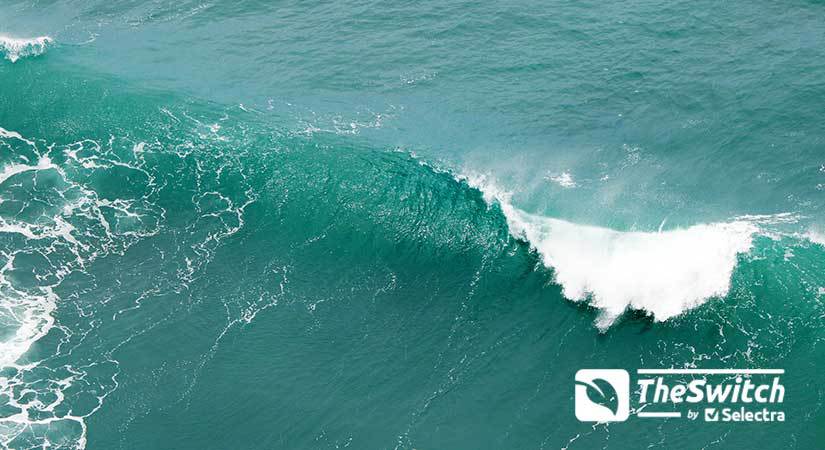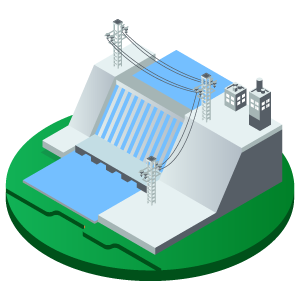Tidal Energy: what is it & how does it work?

Tidal energy is a form of hydroelectric power relying on tides that affect large bodies of water such as bays, estuaries, lakes and inlets in order to generate clean energy from flowing water and ocean currents. Compared to hydropower, wind energy and solar, tidal energy is currently much less popular in the UK due to recent government policy on the development of sustainable energy.
What is tidal energy and how does it work?
Tidal energy is a renewable energy source which harnesses the kinetic energy from tidal currents to produce electricity. Since the movement of water is the key to production of this form of energy, the common component in all tidal energy stations are underwater turbines. Moving water makes the turbines spin, producing electricity both during incoming and outgoing tides. There are four main types of tidal power plant currently in operation or at the planning stage:
Check out our in-depth guide on the proposed Swansea Bay tidal power lagoon project to find out more about how this technology could bring about dependable renewable electricity to the UK.
Tidal barrage
Tidal barrages have much in common with hydroelectric dams and canal locks. They run the width of an estuary where river and seawater meet, leading to a significant change in water level that can be exploited for energy generation.
The power of ebb and flow
The process starts with opening sliding gates, called sluices. They let the incoming tide in until the high tide mark has been reached. Behind the sluice gates, there are turbines that spin as water passes through. Once the tide has flowed in one direction, the sluice gates are firmly shut to retain the water flow and its valuable potential energy.

Once the water level on the other side of the barrage has decreased sufficiently, the gates are opened again so the water can pass through moving the turbines with significant potential energy to boot. The power station turns the movement from the turbines into renewable electricity. With four tidal currents at regular times in any given day, electricity generation is predictable which helps with the operation of the barrage and its sliding gates.
Additionally, a tidal barrage can seamlessly incorporate a lock system to enable continued usage of established shipping lanes.
Pump it up!
Current power grids don’t really have the ability to store electricity which generally means whatever isn’t used is wasted. At the same time, renewable power generators are forced to operate at less than full capacity for fear of overloading the national grid.
The ability for tidal energy turbines to go in reverse is shared with hydropower dam turbines. The point of being able to go in reverse is that allows for water to be pumped from one area to another, often higher, reserve area, often called Pumped Storage.

This process to move water against earth’s gravitational pull obviously requires energy consumption but it also plays a vital regulatory role in our antiquated electrical distribution infrastructure.
Pumped storage can use up excess electrical power output from renewable energy sources by turning it into mechanical energy to move water into storage for later use. These ad-hoc water reserves act as kinetic energy batteries that can be harnessed quickly by releasing water back through submerged tidal turbines. With the extra water volume being pushed through, this will maximise the generating capacity right when it’s most needed while having soaked up the excess electricity in the grid.
Tidal streams
Tidal stream generators are essentially wind turbines designed for underwater use. While tidal barrages can take a long time to build, tidal stream generators, more commonly known as (TEC) tidal energy converters, are much faster to deploy because of their free-standing and independent nature. Unlike the full scale commitment required by tidal barrage projects, operators can easily test the waters with standalone test tidal stream turbines.
Unlike wind turbines, tidal turbines have a higher power output potential than equivalent wind energy counterparts. This is because water is 800 times denser than air which means that even at low tidal flow speeds a tidal turbine will still keep on churning, unlike its wind turbine relatives which are more likely to just sit pretty with low wind speeds.
With all this potential, tidal turbines remain very much bleeding edge technology, there are several competing designs vying for mainstream acceptance.

Axial tidal turbines
These are closely related to traditional wind turbines but instead, they operate out of sight underwater. Axial tidal turbines can be fixed in place through foundations dug straight into the seabed. A more progressive ocean energy alternative is to have a semi-floating turbine tethered by several mountain points. The advantage of the tethered turbine is that it can instinctively orient itself to better face the tidal stream.
Crossflow turbines
If you took an axial turbine and turned it on its side so that its axle is perpendicular instead of parallel to the coastal bed, you get a crossflow turbine. Such a significant change requires a radical redesign of the turbine blades, such as a futuristic-looking helical hydrofoil that can better exploit more sluggish water currents.
Flow augmentation
By surrounding a standard tidal turbine with a shroud and affixing it to the seafloor, you can multiply water flow through the turbine design of your choosing. This variation on standard axial and crossflow designs acts as a supercharger, increasing energy potential.
Tidal kite turbines
This design is flexible enough to move along the tidal stream. The concept dates back to the aftermath of World War II when Europe was reeling from the destruction of much of its energy generating sources.
Tidal kites span an average of 35 feet and they are able to maintain a neutral flotation profile through the ebb and flow cycle. They also have a gearless turbine that transmits power to a transformer connected to the power grid.
What are tidal energy's advantages and disadvantages?
Before evaluating the merits of tidal energy, it’s worth putting in context within the general UK energy industry, from fossil fuels to nuclear power, as well as the other renewable energy resources.
While comparing how much a megawatt of electricity costs with each different energy source, nuclear and fossil fuels will not only become increasingly expensive on generation price alone but they are already prohibitively costly when you account for waste disposal and global warming-related costs.
From the outset, tidal energy is far and away the superior option when compared with brown energy, no matter what drawbacks listed below are.
Advantages of tidal energy
Tidal energy’s potential benefits cannot be denied. When it comes to the UK it should be a fixture in our national energy future.
- Predictable energy generation thanks to the regularity of tide cycles.
- Proven technology operating at utility scale, dating back to the 1960s.
- Adaptable designs suited to site geography, budget and scale.
- Team player balancing other renewables and providing flood mitigation.
- Improved transportation links and water quality.
Disadvantages of tidal energy
The disadvantages of tidal energy are manageable and clearly understandable, especially when compared to the destructive toxicity of fossil fuels and nuclear energy.
- High initial investment due to the scale of some projects.
- Environmental impact regarding the loss of sea life around rotating blades.
- Noise pollution can affect the coastline marine environment.
- Corrosion can be an issue for poorly maintained or designed systems.
UK energy politics and tidal energy

While tidal energy feasibility studies reaching positive conclusions can be traced back to the 1920s, the United Kingdom has all but abandoned the early lead established in 2003 with the foundation of the European Marine Energy Centre (EMEC). This organisation pushed forward the development of a relatively large number of prototype tidal energy designs by providing real-world testing situations.
However several promising projects have lost government backing in recent years. According to Minesto’s CEO, Martin Edlund, “the UK is making a huge mistake”. He is someone who is certainly entitled to comment with his company sinking £25m in groundbreaking tidal energy technology to effectively exploit water currents off the Welsh coastline.
The withdrawal of existing support systems – which are peanuts when compared to the huge subsidies for the Hinkley Point nuclear power plant – leaves the industry without support, I will just turn my back on the UK and go elsewhere. - Dr. Martin Edlund, Minesto CEO
The overwhelming view, here at The Switch, is that the UK should not discard the surefire potential of tidal technology, especially with Brexit just around the corner. No matter how the process of leaving the European Union pans out, the UK government needs to double down and back a variety of renewable initiatives to foster energy independence no matter which way the tide goes.
Tidal power stations in the UK & around the world
There are many tidal power stations, big and small, dotted around estuaries and coastlines around the world. Let’s have a look at some of the most notable ones.
United Kingdom
Being entirely surrounded by water, the UK has unparalleled tidal energy potential, much of it currently untapped.
Strangford Lough tidal stream generator
The Seagen system was based on a standalone two axial turbine design developing 1.2MW of electrical power in Northern Ireland. The turbine rotors could be raised for maintenance purposes. The site generated electricity from 2008 until its closure and dismantling in 2017.
Bluemull Sound tidal stream array
This is a 20 million Euro project based in the Shetlands focussed on proving the tidal concept from design board to decommissioning. The goal is to bring down the cost of tidal energy development and operation by over 40% to increase confidence and investor interest in this renewable option.
Meygen Tidal Project
The project officially launched in 2016 and there are now four turbines capable of outputting 6MW of electrical power. More turbines are planned for the Pentland Firth site to create one of the largest tidal energy projects with a 25-year operational cycle.
Europe
France is the current regional leader when it comes to tidal energy, especially with the recent changes in UK renewables policy.
Rance tidal power station (France)
The grandaddy of all tidal barrage power plants runs across the Rance river estuary in North West coast of France. It was built in a six year sprint during the swinging 60s and it has been generating up to 240MW consistently.
Rest of the world
Sihwa Lake Tidal Power Station (South Korea)
This significant renewable project was built on a seawall that initially was set up for flood protection and agricultural water storage. The newly-built power plant started operating in 2012 and has started to improve the quality of the previously stagnating reservoir by circulating fresh seawater, in addition to reaching a total power capacity of 254 MW.